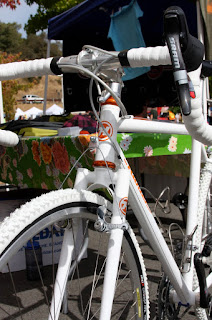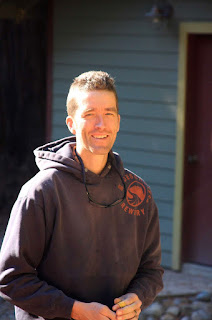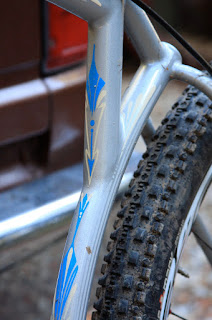| The signs point to Hunter |
A while later, I was working on a project involving people involved with mega-long-distance mountain bike races and Rick’s name popped up again. Now I was really interested. What kind of guy makes bikes, races them almost all year long, and still finds time to design racks and cargo bikes?
So one Saturday morning in November, I drove down the California coast and I met up with Rick Hunter of Hunter Cycles at his home workshop for a chat and some coffee.
| Cargo bike with suicide shifters |
To say Rick Hunter’s workshop is remote is a bit of an understatement. It’s not that Rick a hermit, far from it, it’s just that his place is rather inaccessible. Situated somewhere between Bonny Doon and Felton in California’s Santa Cruz mountains, it’s the kind of a place where you can either get a lot of work done… or no work at all.
When I finally found Rick and his wife, Mary-Anne’s house I reckoned I had come to the right place. The SUV with a Hunter Bicycles sticker on the back was probably my first clue. The second being the BMX pump track in the front yard.
Rick said he had figured it was me because I had driven past his house three times because my sense of direction isn’t really all that good. But he greeted me with a handshake gave me a quick tour of the place, brewed up a strong cup of Joe and sat outside for an interview.
| Ridden hard but well loved |
One of the first things you notice about Rick is that he’s both soft spoken, and straight to the point. He is a man of few words, and he chooses his words carefully, so it’s clear that he thinks a lot about what he says before saying it. Another thing you notice is the dude is tall. How tall? I dunno. I’m 6’4” and even I had to look up while talking to him.
 |
| Hunter's cross bike |
Like some other frame builders, Rick got his feet wet while working in bike shops, then eventually gravitated towards frame building. A step Rick called a “natural progression” from working as mechanic in bike shops. Rick said that he had a couple of friends who were tinkering with frames in their garages and picked it up from there.
After high school, Rick took a year off then went through the industrial arts program at College of Marin. While there, Rick learned valuable machine shop lessons from mountain bike pioneer Craig Mitchell.
When asked what it was like working with Craig Mitchell, Rick just said it was “Interesting…” but after a pause added: “It’s been a long time and unfortunately he’s deceased. As far as a shop teacher he was a good shop teacher and I definitely picked up a lot of basic machine shop techniques from him but I never got the chance to know him very well as a friend”.
Later Rick would spend a little time working at Kestrel’s Watsonville, California factory.
“I worked at Kestrel both freelance from my own location and at their facility over the course of a few years, doing some frame prep-mods-repairs and also some production assembly. Reaching my personal high point of assembling thirteen Talon complete bikes in one day! Got to be proud of something...”
When asked what it was like working with Craig Mitchell, Rick just said it was “Interesting…” but after a pause added: “It’s been a long time and unfortunately he’s deceased. As far as a shop teacher he was a good shop teacher and I definitely picked up a lot of basic machine shop techniques from him but I never got the chance to know him very well as a friend”.
Later Rick would spend a little time working at Kestrel’s Watsonville, California factory.
“I worked at Kestrel both freelance from my own location and at their facility over the course of a few years, doing some frame prep-mods-repairs and also some production assembly. Reaching my personal high point of assembling thirteen Talon complete bikes in one day! Got to be proud of something...”
Rick’s workshop is an eclectic mix of machinery gathered from some of northern California’s frame building heritage: something here from Kestrel, a little this from Bontrager, and a little of that from somewhere else.
“Paul Sadoff and I shared a shop space for about five years on the west side of Santa Cruz. He is still in the same location. I never actually worked or apprenticed under Paul, but I did do a few odd jobs for him, and I learned a bunch of tricks. Otherwise, I was just doing my own thing… We kinda worked a split shift where I would show up later and rock out until late at night. Fun times…”
I asked Rick how he made the transition from shorter races to longer format races he said that early on he became dissatisfied with short format N.O.R.B.A. style cross-country mountain and eventually gravitated towards longer distance races such as Leadville and The Creampuff 100 and, in a somewhat surprising move, cyclocross races. Rick said that he felt the two seemingly contradictory race formats were actually quite complimentary.
“The long distance stuff always came naturally to me. That’s what I was always good at as a kid – hill climbing, just anything over three, four, or five hours, so that was kind of my natural strength. They always seemed to complement one another. You spend the whole summer racing mountain bike so when fall comes around you are too tired to go on long rides any way so I started racing ‘cross after that”.
But, being in the saddle all day during long distance races has its drawbacks. When I asked how he kept himself motivated during longer distance races Rick said, “Find a song a song that sticks in your head. Try to enjoy it basically, which is the hard part. Try to keep a good attitude or set little goals for yourself or find someone who can battle with and pace off of”.
When asked if he found if there were some better brain worms to get stuck in his head than others Rick said, “No, it’s usually something you don’t like, like Janet Jackson or something…”
Rick also gave his recommendation for people who were planning on entering longer distance races: “Don’t overdo it. Don’t get too serious. Your health is way more important than any dumb mountain bike race. I’ve seen people burn out and really put themselves in a hole for a long time, unfortunately”.
“Over-training is a big thing. I don’t think they [ultra-marathons] are healthy to do at this point. This year, I’ve only done one hundred-miler this year, and I defiantly felt it the rest of the summer. I’m not saying, ‘Don’t do them’ just be careful, have a good time”.
Fellow long distance mountain bike racer, Scot Morris, mentioned that he was also only able to do a small number of these races a year due to some nerve damage he has been experiencing afterwards. Rick said that there were other risks to long distance mountain bike races: “People wind up in the hospital, People wind up with nerve damage, people contract [the] Epstiein-Barr [virus]”.
However, Rick said that entering longer races helped him with frame design.
“I try to build in comfort a lot and durability. Comfort and ergonomics come into play – where I put my water bottle mounts, I usually put them up higher so they are easier to grab so you don’t have to bend down as much, just little things like that”.
While riding longer distance races Rick was able to discover a couple of things about himself during the process: “How you can feel bad, How you can feel good eventually, How you can keep going, How your mood can swing, How your legs can swing back and forth from feeling good and bad, Pacing yourself, Finding a rhythm, Steady breathing, Learning how to breathe, Learning how to be comfortable on a bike, Learning how to stretch while on a bike - Stay fed!”
 |
| A Hunter signature touch |
I asked Rick how he made the transition from shorter races to longer format races he said that early on he became dissatisfied with short format N.O.R.B.A. style cross-country mountain and eventually gravitated towards longer distance races such as Leadville and The Creampuff 100 and, in a somewhat surprising move, cyclocross races. Rick said that he felt the two seemingly contradictory race formats were actually quite complimentary.
“The long distance stuff always came naturally to me. That’s what I was always good at as a kid – hill climbing, just anything over three, four, or five hours, so that was kind of my natural strength. They always seemed to complement one another. You spend the whole summer racing mountain bike so when fall comes around you are too tired to go on long rides any way so I started racing ‘cross after that”.
But, being in the saddle all day during long distance races has its drawbacks. When I asked how he kept himself motivated during longer distance races Rick said, “Find a song a song that sticks in your head. Try to enjoy it basically, which is the hard part. Try to keep a good attitude or set little goals for yourself or find someone who can battle with and pace off of”.
When asked if he found if there were some better brain worms to get stuck in his head than others Rick said, “No, it’s usually something you don’t like, like Janet Jackson or something…”
| Hunter Cycles world headquarters |
“Over-training is a big thing. I don’t think they [ultra-marathons] are healthy to do at this point. This year, I’ve only done one hundred-miler this year, and I defiantly felt it the rest of the summer. I’m not saying, ‘Don’t do them’ just be careful, have a good time”.
Fellow long distance mountain bike racer, Scot Morris, mentioned that he was also only able to do a small number of these races a year due to some nerve damage he has been experiencing afterwards. Rick said that there were other risks to long distance mountain bike races: “People wind up in the hospital, People wind up with nerve damage, people contract [the] Epstiein-Barr [virus]”.
 |
| The man |
“I try to build in comfort a lot and durability. Comfort and ergonomics come into play – where I put my water bottle mounts, I usually put them up higher so they are easier to grab so you don’t have to bend down as much, just little things like that”.
While riding longer distance races Rick was able to discover a couple of things about himself during the process: “How you can feel bad, How you can feel good eventually, How you can keep going, How your mood can swing, How your legs can swing back and forth from feeling good and bad, Pacing yourself, Finding a rhythm, Steady breathing, Learning how to breathe, Learning how to be comfortable on a bike, Learning how to stretch while on a bike - Stay fed!”
I asked Rick since he is both a long-term frame builder and racer, if he may see things a little different that a casual rider may not, if there is something he builds in that others may overlook.
“Versatility,” said Rick, “not being able to only do a specific thing. All the modern road bikes only fit so big of tire. You’re afraid to ride it anywhere other than a smooth road. Fit - a lot of bikes only come in three or four sizes. Durability. Cost. You can have as much fun on a six hundred dollar bike as you can on a six thousand dollar bike. This may not be the best thing to say for my business but I don’t think you need such an expensive bike”.
“Versatility,” said Rick, “not being able to only do a specific thing. All the modern road bikes only fit so big of tire. You’re afraid to ride it anywhere other than a smooth road. Fit - a lot of bikes only come in three or four sizes. Durability. Cost. You can have as much fun on a six hundred dollar bike as you can on a six thousand dollar bike. This may not be the best thing to say for my business but I don’t think you need such an expensive bike”.
Often overlooked is the fact that not only is frame building an art form, it’s also a business. Recently, I’ve talked to a couple of frame builders how they were weathering the current up and downs with the economy. One said that they were doing all right and hadn't really noticed a drop off in business, while another said it was the worst financial period he’d had in thirty years.
I asked Rick what advice he had for people who want to become a frame builder.
“Mary-Ann and I, (my wife) laugh about that question all the time. I think one of my responses at one of the trade shows is ‘What does your wife do?’ or ‘How good of job does your wife have?’”
“Honestly? Start small, and start slow. That’s not to say I’m making a lot of money right now, but I’m not in debt. Don’t try to be Mr. Hotshot right away because it’s going to take a lot of time.”
“Your biggest asset … is just your own personal skill: it’s not your tools, it’s not your $5,000 jig, it’s just the time you put in learning how to do it yourself.”
There are several places that either specialize in bicycle frame building classes, and I asked Rick if he thought it was better to enroll in such a narrowly focused school or if it were better to take machine shop classes at a community college.
“I think it depends what kind of frame you want to build. But, to become a machinist, to become a welder, then you can build whatever you want. So, a bike, that’s just a simple structure. To build a bike once you have the base to be a machinist, or a craftsman or a welder, it’s not that difficult. A basic bike frame itself is not black magic”.
"A basic frame itself is not black magic"
 |
| "A basic frame itself is not Black Magic." |
“That being said I’m also trying to say ‘no’ more, and build more of the bikes I want to build”.
If one wanted to become a fabulously wealthy cyclist, competing in long distance mountain bike races isn't the way to do it. I asked Rick what he thought was compelling about entering longer events since there isn't any money involved.
“The reason why I've stuck to mountain bike racing is just the beauty of it. Being out in the woods and riding single track; the serenity of it. I've only legitimately won one sanctioned race in my life. I won some outlaw races so winning was never a big part of it. And that goes with frame building. Making money was never a big part of it. At this point it’s all I know and it pays the bills - to a certain extent”.
I asked Rick what he be doing if he were not making bike frames?
“As a machinist I could have worked for Chevron but I don’t think I would have lasted very long doing that. I've always been interested in architecture, or even being a ranger”.
Who is the faster builder Curtis Inglis (L) Rick Hunter (R) ?
| Who is the faster builderCurtis Inglis (L), or Rick Hunter (R)? |
In closing, I asked Rick what was the one thing people should know about him:
“Good bikes. I’m still in business”.
Like I said, Rick is a man of few words.
If you find yourself lost in the hills around Santa Cruz and you see a single story house with a big dog and a pump track in the front yard, it may very well be Rick’s place. Now, there isn’t any guarantee that he’s going to drop what he’s doing and shares a strong cup of coffee with you but don’t rule it out either.
Rick uses a mixture of True Temper, Columbus and Dedacciai steel hand his frames start at $1,500 on up. Rick also makes fillet brazed frames starting at $2000. Additionally Rick makes rigid forks starting at $275 and stems starting at $150.
Frames, stems, forks, and complete bikes are available direct from Rick Hunter or through Bike Heaven, Geneva IL, Circles Bike Shop Nagoya Japan, Monkey Wrench Cycles in Lincoln Nebraska and The Freewheel San Francisco CA.
Contact:
http://www.huntercycles.com/
http://www.flickr.com/photos/huntercycles/
No comments:
Post a Comment